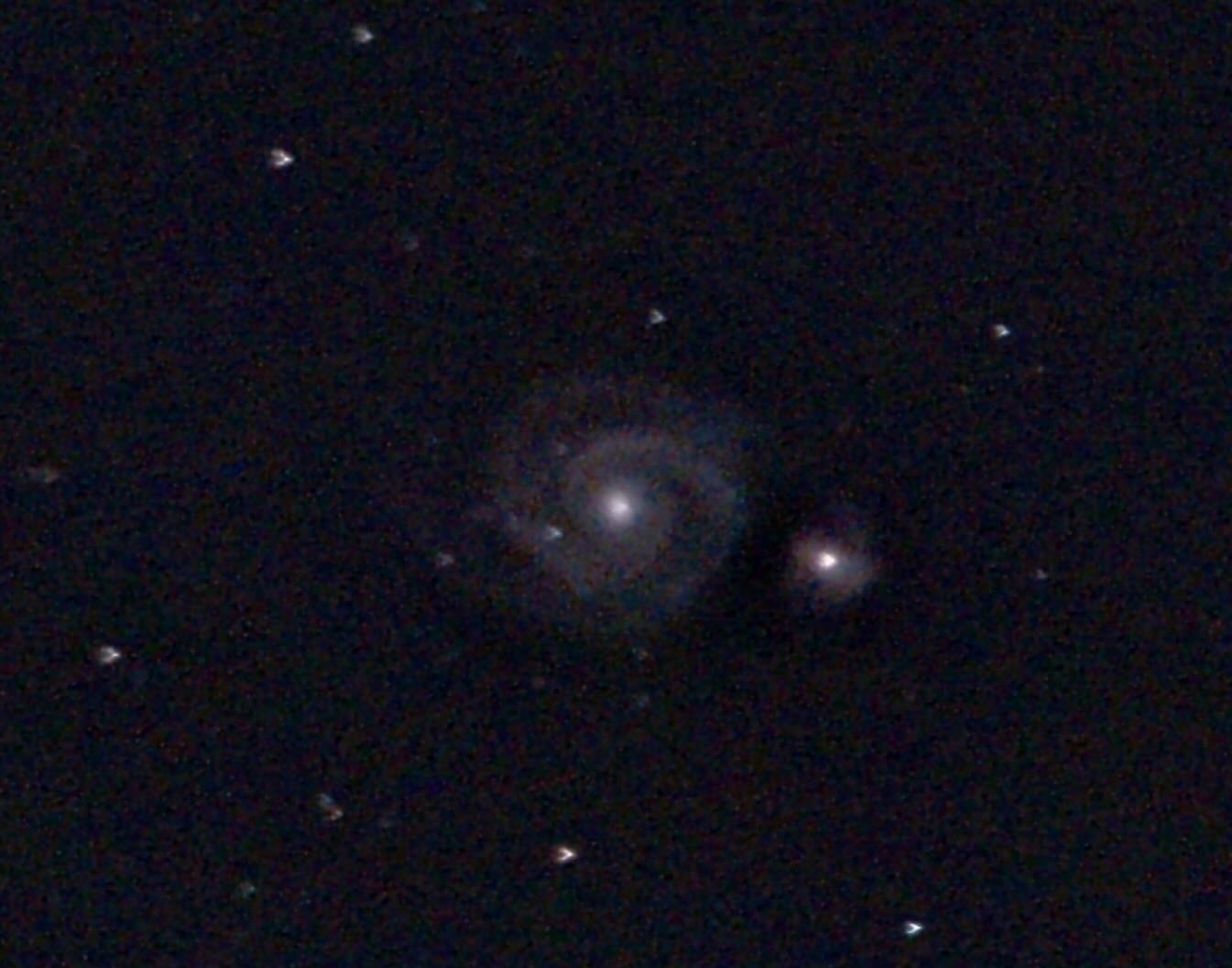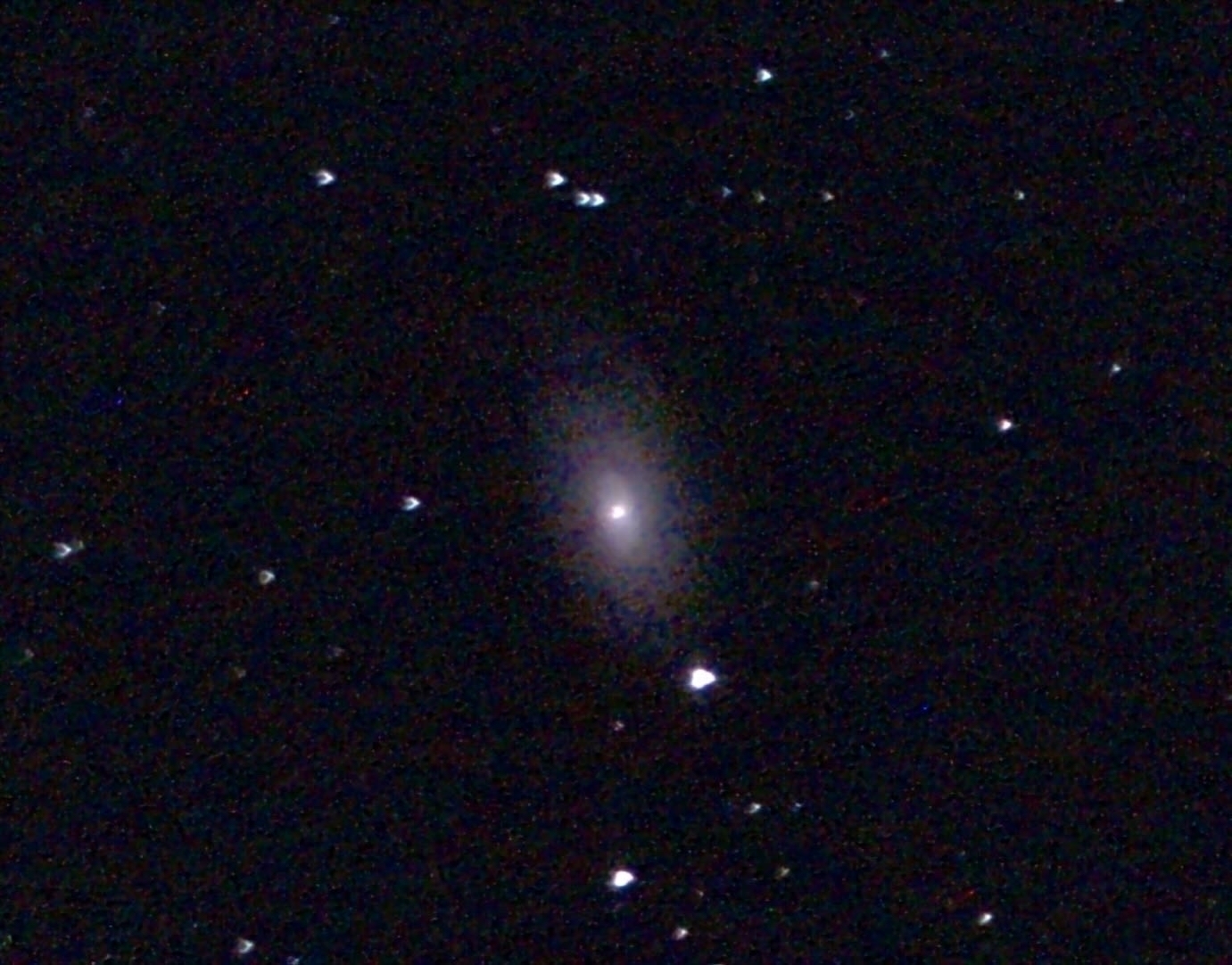-
Astronomy Photo: M101 Pinwheel Galaxy
My observation:

Taken: 1 June 2024 at 10:57 PM EST
Equipment: Unistellar Equinox2
General Information:
- Messier Designation: M101
- Type: Spiral Galaxy
- Distance from Earth: 21,000,000 light years
The Pinwheel Galaxy, known as Messier 101 (M101), is a face-on spiral galaxy situated approximately 21 million light-years away in the constellation Ursa Major. This galaxy is renowned for its well-defined spiral arms, which are adorned with a multitude of star-forming nebulae, young blue star clusters, and vast regions of ionized hydrogen. These features make it a dazzling example of a grand design spiral galaxy. M101 spans about 170,000 light-years across, making it one of the largest galaxies in its local group. Its proximity and relative brightness allow astronomers to study its composition and structure in great detail, contributing significantly to our understanding of the dynamics and evolution of spiral galaxies.
Additional Details from NASA:
Hubble Image:
https://science.nasa.gov/wp-content/uploads/2023/04/m101-jpg.webp?w=2048&format=webp

-
Astronomy Photo: M51 Whirlpool Galaxy
My Observation:

Taken: 1 June 2024 at 10:45 PM EST
Equipment: Unistellar Equinox2
General Information:
- Messier Designation: M51
- Type: Spiral Galaxy
- Distance from Earth: 23,000,000 light years
The Whirlpool Galaxy, also known as Messier 51 (M51), is a classic spiral galaxy located approximately 23 million light-years away in the constellation Canes Venatici. This galaxy is famed for its striking appearance and well-defined structure, featuring prominent spiral arms that coil tightly around its luminous core. M51 is particularly noted for its grand design spiral structure, which is rich in star-forming regions, pinkish nebulae, and clusters of young, hot stars. It is often paired with a smaller companion galaxy, NGC 5195, which appears to be interacting with M51, enhancing its spiral structure through gravitational forces. This interaction has made M51 a popular subject in both professional astronomical research and amateur astrophotography, providing valuable insights into the dynamics of galaxy formation and evolution.
Additional Details from NASA:
Hubble Image:
https://science.nasa.gov/wp-content/uploads/2023/04/m51-and-companion_0-jpg.webp?w=2048&format=webp

-
Astronomy Photo: M63 Sunflower Galaxy
My Observation:

Taken: 1 June 2024 at 11:02 PM EST
Equipment: Unistellar Equinox2
General Information:
- Messier Designation: M63
- Type: Spiral Galaxy
- Distance from Earth: 27,000,000 light years
The Sunflower Galaxy, also known as Messier 63, is a stunning example of a spiral galaxy located approximately 27 million light-years away in the constellation Canes Venatici. This galaxy is particularly noted for its intricate spiral arms, which are densely packed with star-forming regions, clusters of young blue stars, and lanes of dark dust, giving it a striking resemblance to a sunflower. Its bright core and the graceful sweep of its arms are highlighted by the backdrop of space, making it a favored subject of study among astronomers. The Sunflower Galaxy is part of the M51 Group, a galaxy group that includes the famous Whirlpool Galaxy, and its relatively bright appearance makes it a popular target for both professional and amateur astronomers.
Additional Details from NASA:
Hubble Image:
https://science.nasa.gov/wp-content/uploads/2023/04/potw1536a-jpg.webp?w=2048&format=webp

-
Astronomy Photo: Moon
My observation:

Taken: 20 May 2024 at 9:36pm EST
Equipment: Unistellar Equinox2
General Information:
- Type: Moon
- Distance from Earth: 384,400 km
The Moon, Earth’s only natural satellite, is a rocky body with a geologically diverse surface, characterized by vast plains called maria, impact craters, and highland regions. Its geology includes basaltic plains from ancient volcanic activity and anorthosite highlands, shaped significantly by asteroid impacts. The Moon orbits Earth at an average distance of about 384,400 kilometers, completing a revolution in approximately 27.3 days, which also matches its rotational period, resulting in the same side always facing Earth (synchronous rotation). This orbital relationship profoundly affects Earth’s tides and stabilizes its axial tilt, contributing to a stable climate over geological time scales. The interplay of tidal forces also causes a gradual increase in the Moon’s distance from Earth by about 3.8 centimeters per year.
Additional Details from NASA:
https://science.nasa.gov/moon/
Lunar Reconnaissance Orbiter Image:

-
Beautiful night sky in MA with the solar storm!





-
Astronomy Photo: M13 Hercules Globular Cluster
My observation:

Taken: 4 May 2024 at 1:51AM EST
Equipment: Unistellar Equinox2
General Information:
- Messier Designation: M13
- Type: Globular Cluster
- Distance from Earth: 22,000 light years
M13 Hercules is a globular cluster that is located in the constellation Hercules, visible in the northern sky. It contains hundreds of thousands of stars that are densely packed in a spherical shape, with the cluster covering an area of about 145 light-years in diameter. Discovered by Edmond Halley in 1714, M13 Hercules is considered one of the most prominent and best known globular clusters, seen with a telescope from earth due to its proximity at about 22,200 light-years away. The stars within it are believed to be extremely old, estimated at around 11.65 billion years, with tightly gravitational interaction, leading to high rate of stellar interactions and collisions. This cluster is a popular target for both professional and amateur astronomers due to its size, brightness, and the myriad of stars present.
Additional Details from NASA:
Messier 13 (The Hercules Cluster) - NASA Science
Hubble Image:

Bonus photo: Hercules … with a few photobombing satellites!

-
Astronomy Photo: M82 Cigar Galaxy
My Observation:

Taken: 4 May 2024 at 2:18 AM EST
Equipment: Unistellar Equinox2
General Information:
- Messier Designation: M82
- Type: Spiral Galaxy
- Distance from Earth: 12,000,000 light years
M82, commonly known as the Cigar Galaxy, is a starburst galaxy located in the constellation Ursa Major, approximately 12 million light-years away from Earth. This galaxy is characterized by its intensely active star-forming regions, which have given it a unique, irregular cigar-like shape. The starburst activity in M82 is thought to have been triggered by interactions with its neighboring galaxy, M81, leading to a massive concentration of gas and dust in the galaxy’s core. This abundant material fuels the rapid birth of new stars at a rate about ten times higher than in typical galaxies. Additionally, M82 is recognized for its supernova events and the strong ‘superwind’ of ionized matter being expelled from its core, producing streaks known as ‘filaments’. Remarkably, M82 is the closest place to Earth where the conditions resemble those in the early universe, making it a focal point for astronomers studying galaxy formation and evolution.
Additional Details from NASA:
Hubble Image:

-
Astronomy Photo: Sombrero Galaxy
My observation:

Taken: 4 May 2024 at 2:03AM EST
Equipment: Unistellar Equinox2
General Information:
- Messier Designation: M104
- Type: Spiral Galaxy
- Distance from Earth: 28,000,000 light years
M104, often referred to as the Sombrero Galaxy, is a spiral galaxy located in the constellation Virgo, over 28 million light-years away from the Earth. This galaxy was named ‘Sombrero’ due to its visual similarity to the broad-brimmed Mexican hat, presenting a unique edge on view with a prominent dust lane circling its bright nucleus like a brim. The mass of the Sombrero galaxy, particularly the budge in the middle, is comprised of billions of stars, dust, gas, and other celestial matter. Additionally, the rim of the Sombrero Galaxy showcases an extensive halo filled with several hundred globular clusters, signifying its significantly higher than average number for a galaxy of its type and size. It is also a source of a strong radio emission and is assumed to possess a supermassive black hole at its center. The Sombrero galaxy is a popular celestial body in amateur astronomy due to its bright intensity and visibility with small telescopes.
Additional Details from NASA:
Hubble Image:

-
Astronomy Photo: M56
My Observation:

Taken: 27 April 2024 at 1:34AM EST
Equipment: Unistellar Equinox2
General Information:
- Messier Designation: M56
- Type: Globular Cluster
- Distance from Earth: 33,000 light years
Messier 56, or M56, is a globular cluster located in the constellation Lyra, roughly 33,000 light-years away from Earth. Discovered by Charles Messier in 1779, M56 is composed of hundreds of thousands of ancient stars densely packed into a spherical shape, which is typical of globular clusters. The cluster’s stars are gravitationally bound, sharing a common motion through space, and are characterized by their old age and low metallicity, reflecting the early stages of the Milky Way’s formation. M56 appears relatively faint in the night sky, making it a challenging but rewarding target for amateur astronomers equipped with telescopes. This cluster provides valuable clues about the early chemical environment of the galaxy and the evolutionary history of stellar populations.
Additional Details from NASA:
Hubble Image:

-
Astronomy Photo: Ring Nebula
My Observation:

Taken: 27 April 2024 at 1:28AM EST
Equipment: Unistellar Equinox2
General Information:
- Messier Designation: M57
- Type: Planetary Nebula
- Distance from Earth: 2000 light years
The Ring Nebula, also known as Messier 57 (M57), is a stellar nebula located approximately 2000 light years away from Earth. It is a striking example of a planetary nebula, formed when a dying star sheds its outer layers of gas, creating a ring-like structure of glowing gas and dust. The central star, a white dwarf, is the remnant of the star that once existed in the center of the nebula. The Ring Nebula is a popular target for amateur astronomers due to its bright and distinctive appearance in the night sky.
Additional Details from NASA:
Hubble Image:

-
Astronomy Photo: Dumbbell Nebula
My Observation:

Taken: 27 April 2024 at 1:37AM EST
Equipment: Unistellar Equinox2
General Information:
- Messier Designation: M27
- Type: Planetary Nebula
- Distance from Earth: 1360 light years
The Dumbbell Nebula, also known as Messier 27 (M27), is a planetary nebula located in the constellation Vulpecula, approximately 1,360 light-years away from Earth. It is one of the brightest and largest planetary nebulae visible in the night sky, making it a popular target for amateur astronomers. The nebula was discovered by Charles Messier in 1764 and is named for its distinctive dumbbell shape, characterized by a bright, elongated central region surrounded by a complex structure of gas and dust. The Dumbbell Nebula is the result of a star similar to the Sun expelling its outer layers into space at the end of its life, illuminating the surrounding gas to create the nebula’s vivid colors and intricate appearance. This celestial phenomenon offers insights into the life cycle of stars and the processes that shape the interstellar medium.
Additional Details from NASA:
Spitzer Space Telescope Image:
